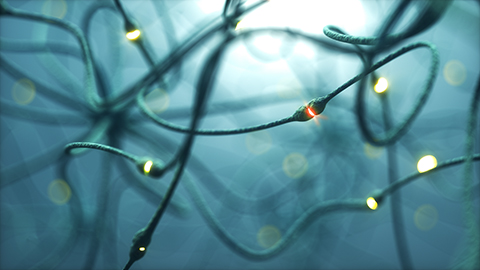
In this episode, a client might be disappointed. A therapist is very concerned. And we don’t know what will happen next.
When a “pinched nerve” that has been quiet for six months suddenly creates symptoms in the middle of a massage, what’s a therapist to do? We will talk about what could be going on here (including some fascinating things about nerve-generated pain) and what the best next steps could be.


This episode is sponsored by Books of Discovery and Anatomy Trains.
00:00 Speaker 1: Ruth Werner's best-selling book, A Massage Therapist's Guide to Pathology is a highly regarded comprehensive resource that sets the standard for pathology education. Written for massage therapy students and practitioners, this groundbreaking resource serves up a comprehensive review of the pathophysiology, signs, symptoms and treatment of more than 500 diseases and disorders. Learn more at booksofdiscovery.com.
[music]
00:39 Ruth Werner: Hi, and welcome to I Have a Client Who, pathology conversations with Ruth Werner, the podcast where I will discuss your real life stories about clients with conditions that are perplexing or confusing. I Ruth Werner, author of A Massage Therapist's Guide to Pathology. And I have spent decades studying, writing about and teaching about where massage therapy intersects with diseases and conditions that might limit our client's health, we almost always have something good to offer even with our most challenged clients, but we need to figure out a way to do that safely, effectively and within our scope of practice, and sometimes as we have all learned, that is harder than it looks. In this episode, we have a disappointed client, maybe a concerned massage therapist, and some questions about what should happen next. This story comes from a massage therapist in Charlotte, North Carolina, who says, "I have a client who recently came to me for the very first time, she was around age 30 and basically healthy, although she used medication to manage epilepsy. She told me she'd had a pinched nerve in her neck on her left side for six months that had given her a lot of trouble, but recently it had gotten much better. She had used steroids prescribed by her general practitioner, but had no other therapy, all while she was prone during the session.
02:12 RW: She seemed uncomfortable, she kept trying to turn her head to one side, which may have been a combination of trouble with her neck and discomfort with wearing a mask. So to improve her experience, I had her turn supine earlier than I normally would. And in that position, I worked on her legs and her arms, and then I worked on her neck, focusing mainly on trapezius and the suboccipital triangle. I did a little bit of side flexion and rotation, but nothing major, in fact, she ordered deeper work in general, but I never got really specific in her anterior or lateral neck. While she was supine, I worked on her neck and shoulders, which is my favorite part, everybody always loves this part. And she said she was feeling that regional nerve pain again in her deltoid and then finally all the way down into her hand. Nothing I did seem to change it, so I finished with that part of her body and spent a few minutes on her feet, and after her session, I showed her some good stretches that she might do to help resolve some of her symptoms, still she seemed disappointed, or maybe I just feared that she was disappointed or irritated, the thing is, I just never had someone have a response like this, and she seems like she could be a really good client, and I want to do what I can to help her be happy with my work."
03:38 RW: So first, as always, thank you so much to this massage therapist who was willing to share her story with us, especially since this is a story in which she feels she might have done something wrong, that takes a lot of guts, and we can all be grateful for her willingness to share. If you have a story to share that you might feel would be helpful to other massage therapists, I'd love to give you that opportunity, you can do that by sending your story to ihaveaclientwho@abmp.com, that's ihaveaclientwho, all one word, all lowercase @abmp.com. So let's think about our client with a nerve pain in her left arm, in my original communication with this massage therapist, she thought it was likely that the client had some form of thoracic outlet syndrome, but that had never been officially diagnosed or recognized, and also...
04:35 RW: Well, this was a first-time client for this therapist, the woman had had massage in the past, she was not new to massage therapy, so what could cause this sensation of a pinched nerve in the neck? The brachial plexus comprises nerve roots, C5 to T1, and these five spinal nerves emerge from the intervertebral foramina, and they slip between the anterior and medial scalenes and they go under the coracoid process and between the clavicle and the first rib, and then they split out into the axillary, musculocutaneous, median, radial, and ulnar nerves that supply the arm, and lots of things could cause a nerve sensation because there's lots of places for these parts of the brachial plexus to get irritated.
05:30 RW: Any combination of these things could cause intermittent or persistent symptoms of nerve entrapment or stretching or torsion, and this could include things like a cervical disc that is bulging outside its normal boundaries, or maybe a bone spur in the neck that puts pressure on a nerve root or maybe a cervical rib, that's a situation where the transverse processes at C7 grow extra wide and that can happen on one side or on both sides, and what this massage therapist thought was that this could have been some form of thoracic outlet syndrome, which is a neurovascular entrapment of some part of the brachial plexus or maybe also blood vessels too and from the arm, that occurs somewhere between the neck and shoulder, that could involve things like excess bands of connective tissue in the neck, and of course the contributors of muscular imbalance that makes the flexors sort of tight and compressed and the extensors stretched and weak. So any of these factors or combinations of these factors can put pressure on one or multiple bits of the brachial plexus. Here's the thing about nerve compression that I came to fairly late in my understanding of nerve injuries.
06:54 RW: We will recall that in the peripheral nervous system, nerves are composed of long fibers, those long axons that are all wrapped up in a connective tissue packaging called the epineurium and the epineurium is meant to be quite dense and tough and protective. Well, what this means is that if one area of a peripheral nerve is irritated and inflamed, that excess fluid, that inflammation can affect the entire length of that nerve, and so if we put this, say in the context of the median nerve, if that median nerve is entrapped at the carpal tunnel, we call that carpal tunnel syndrome, we have inflammation right there, but that inflammation can affect the entire length of the median nerve, so any other place that that nerve might become stretched or twisted or entrapped, it will get irritated.
07:53 RW: And so that can happen, say, at the elbow and in other locations, and that's why carpal tunnel syndrome sometimes shows symptoms in the forearm and up the arm, which would otherwise be sort of counter-intuitive. Now, this client has this going the opposite direction, for this client we've got irritation of some part of the brachial plexus and it's never been determined which part, starting in her neck or in her shoulder, and the whole nerve is affected and that can cause symptoms going all the way down her arm and into her hand. Now, it could just be nerve sensation to start, right? Then the sensory neuron is zipping sensations along the entire length, but if this persists, the whole nerve may become inflamed, that understanding of function and nerve generated pain, neurogenic pain, took me a long time to understand and I'm just so grateful to the very, very patient teachers who helped me finally to really understand this.
08:54 RW: So the big question, of course, is, what is the role of massage in this context? This situation came up in the middle of the session, it was not part of the client's original complaints, it was not part of her goals with massage to deal with any kind of nerve pain, and so it would have been really hard for this massage therapist to anticipate how to minimize this risk or how to approach this problem with bodywork, because we don't know what the contributing factors are, we don't know what causes inner pain, we don't even know which nerve it was. And it was not a problem when the client walked in the door, this was a situation that had lasted for several months and then had cleared up with the use of prednisone, that's a hardcore anti-inflammatory. So this suggests that the client's original symptom was related to some kind of inflammation, but maybe not related to some kind of hard tissue problem, like a bone spur or a cervical rib.
09:51 RW: For that reason, if she were to come again, I would suggest that this therapist work especially carefully about her positioning on the table so she's super comfortable and to focus on de-congesting sorts of strokes that would allow freedom of movement and freedom of fluid flow in the area of this person's left neck and shoulder. Therapists who are educated in orthopedic injuries may also have some more specific kinds of tests or assessments that they want, that they might want to conduct and that might reveal other hands-on strategies, which would be great, obviously, it would be preferable to know what the source of this nerve irritation is so that the client has some targeted strategies to care for it, and the therapist has some strategies to minimize the risk of exacerbating symptoms, and that would look really different if the situation is related to a neck injury versus thoracic outlet syndrome or some other kind of nerve entrapment issue.
10:51 RW: The other thing this therapist might do in her follow-up communications with this client is to recommend that if the symptoms don't abate pretty quickly, she should probably consult with her general practitioner again to try to get on top of this so it doesn't take six months to clear up. So what do you think? Can this therapist-client relationship be saved? The therapist plan is to follow-up with the client to see how she progresses within a day or two after her session, at that point, if the client wants to re-book, the opportunity will be open, but the therapist is understandably concerned that because this happened and she was unable to "fix it" in the moment, the client might not wanna work with her anymore, really the only thing she can do is exactly what she's doing, she is professionally expressing her concern and offering good counsel about stretching and follow-up care. I also hope she takes excellent session notes and documents what happened in this session, so she has a record that she can refer back to for future work. I expect that we have all been in the situation of making some kind of mistake with clients, even with the very best of intentions and maybe losing clients over it.
12:09 RW: This has certainly happened to me. And nerve irritation is notorious for showing up with little or no stimulus or precipitator at all, and the whole situation was just really bad luck for the client and also for the therapist, it doesn't have to be a serious or long-term problem, I really hope they are able to continue to work together because it's clear that this therapist is dedicated to doing a good job. Hey everybody, thanks for listening to I Have a Client Who, pathology conversations with Ruth Werner, remember, you can send me your I have a client who stories to ihaveaclientwho@abmp.com, that's ihaveaclientwho, all one word, all lowercase @abmp.com. I can't wait to see what you send me and I'll see you next time.
13:08 S1: Anatomy Trains and the Laboratories of Anatomical Enlightenment are excited to invite you to Dissection Livestream, a regional and layered journey through the human body with Tom Myers and Todd Garcia. September 11th through 14th, student Jan Ball, who attended the last Dissection says, "The whole livestream Dissection course was truly a unique educational experience. It was profoundly moving, I gained so much from it. It was one of the most valuable educational opportunities that I've had, I'm truly grateful to Tom, Todd and the whole team of people involved who made this unique opportunity available." This experience will be delivered through Zoom webinar with high quality audio and video, multiple perspectives and time for questions visit anatomytrains.com for dates and details.